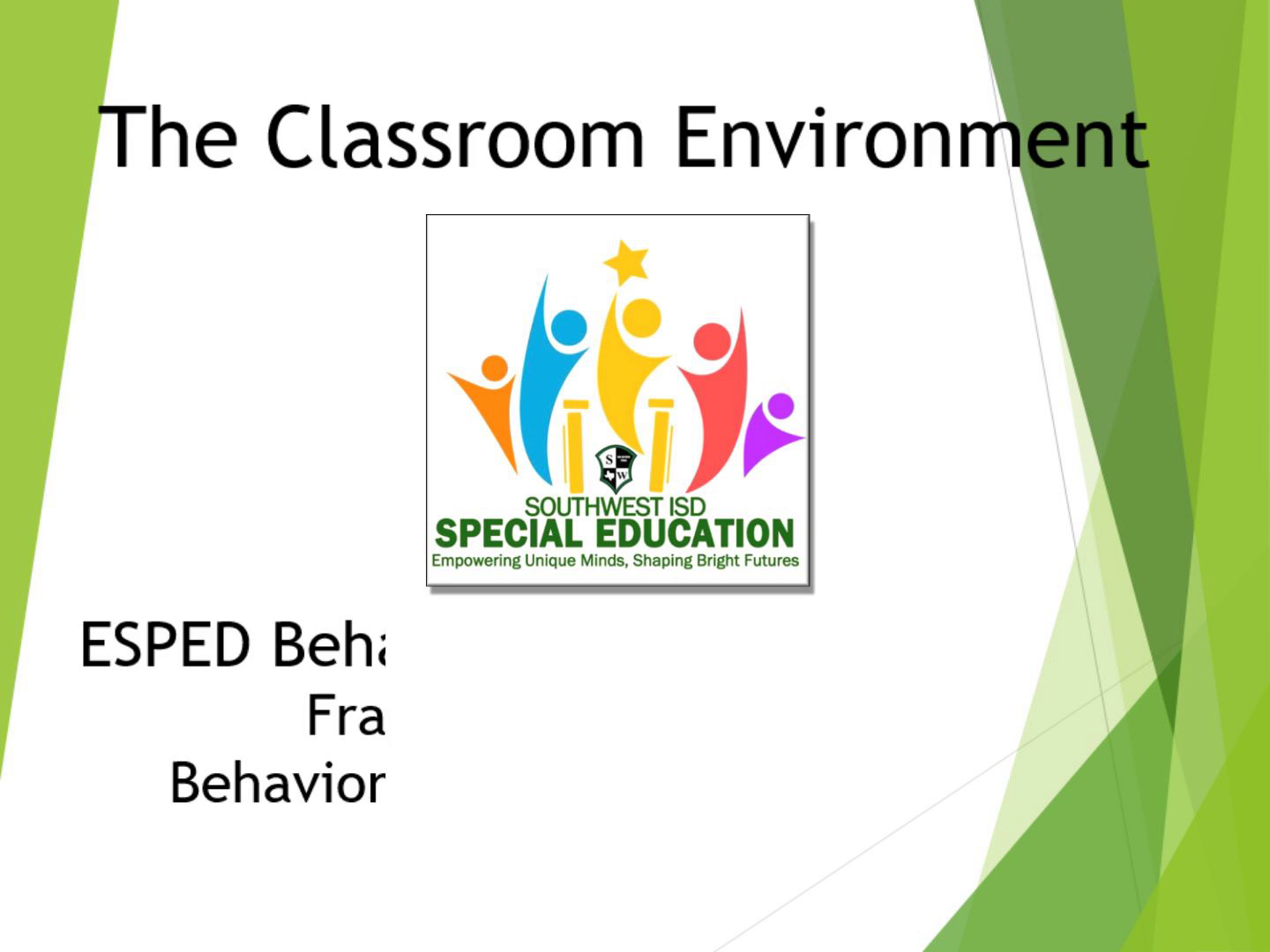
The Classroom Environment
Scene 1 (0s)
The Classroom Environment. s SOUTHWEST ISD SPECIAL EDUCATION Empowering Unique Minds, Shaping Bright Futures.
Scene 2 (4s)
[Virtual Presenter] “This instructional module will cover. Setting Well-defined Limits Removing Distractions Providing a Structured Environment Establishing Consistent Routines and Task Expectations and Providing a Safe Area.
Scene 3 (20s)
[Virtual Presenter] The connection between social emotional learning and classroom management is well-documented. Classroom management is improved by combining social emotional learning with the principles of planning, environment, relationships, and observation. Effective classroom management “must be planned.”.
Scene 4 (41s)
[Virtual Presenter] Teachers can use simple rules selected by themselves prior to students entering the classroom or wait until the first day to collaborate with students to decide on the best rules for the class. Rules should be clear, simple and limited..
Scene 5 (57s)
[Virtual Presenter] The rules should be visible in the classroom for students to reference when a reminder is needed. Positive rewards can be in place for individuals or whole-class rule following..
Scene 6 (1m 10s)
[Virtual Presenter] Practice common and consistent procedures. If students know what is expected for daily routines such as filing out for recess, unpacking books, lining up or taking a bathroom break, there will be far less chaos, confusion and disruption. It’s also a great idea to offer rewards or incentives if students consistently follow the class rules..
Scene 7 (1m 35s)
[Virtual Presenter] Distractions can be incredibly costly. Research suggest that it can take some students up to 23 minutes to get back on-task after being distracted..
Scene 8 (1m 48s)
[Virtual Presenter] Take steps to prevent both yourself and your students from becoming distracted. Remove distracting items and post a “Do Not Disturb” sign on your classroom door during important activities such as tests or exercises that require a great deal of concentration..
Scene 9 (2m 8s)
[Virtual Presenter] It is inevitable that every now and then the classroom may get noisy. Often it is like a domino effect, one starts talking and then like a wave it takes over the entire classroom..
Scene 10 (2m 21s)
[Virtual Presenter] The free browser app Bouncy Balls is a fun tool where students are challenged to keep a bunch of colored balls of different sizes settled/motionless just through how quiet they are in class. When students are too loud and the balls jump too high in the air, a visual and auditory warning appears across the screen telling students to settle down. “Shhhh!”.
Scene 11 (2m 46s)
[Virtual Presenter] Positive reinforcement is a key factor in helping students be more cooperative and exhibit desired learning behaviors. Verbally acknowledge students for making good choices. Use stickers, coupons, and group trips to reward children for making progress. Use charts and other visual aids to help students see their daily progress. Create a level system to help students monitor their progress and earn privileges..
Scene 12 (3m 14s)
[Virtual Presenter] Classroom routines can positively affect students’ academic performance as well as their behavior, therefore, one proactive strategy is for teachers to adopt a consistent classroom routine. A routine is simply a set of procedures for handling both daily occurrences (e.g., taking attendance, starting a class period, or turning in assignments), and managing interruptions of instruction..
Scene 13 (3m 42s)
[Virtual Presenter] Essentially, once taught, routines are daily activities that students are able to complete with little or no teacher assistance, which accomplishes two objectives (a) students have more opportunity to learn and (b) teachers can devote more time to instruction. Routines also help to create smoother transitions between activities and therefore allow fewer opportunities for disruptions to occur..
Scene 14 (4m 8s)
[Virtual Presenter] Interactive routines include knowing how to participate in discussions, behaving as expected in groups at centers, and following rules for getting the teacher’s attention. Once these routine tasks are identified, teachers should establish clear, discrete procedures for handling routine events that are simple, easy for students to understand, and quick for them to perform..
Scene 15 (4m 31s)
[Virtual Presenter] Administrative procedures include activities such as; storing coats or books, using the restroom, sharpening pencils, taking attendance, making announcements, dismissing students to go to another classroom, the playground, or home. Instructional tasks include, getting every student’s attention for instruction, reviewing previous concepts, or working out math problems on the board. This ensures that students behave in ways that maximize positive outcomes during activities like; teacher-led instruction, group-work, and independent work..
Scene 16 (5m 6s)
[Virtual Presenter] As the understanding of S.E.L. has increased, so has the use of classroom safe areas. Often described as “S.E.L. in action.” The “Safe Area” is a center where children can go to change their inner state from upset to composed, in order to optimize learning. It is the centerpiece of your self-regulation program. A beanbag, throw rug, or pillow can serve as a base for your Safe Area..
Scene 17 (5m 33s)
[Virtual Presenter] Safe spaces are places where children can go to calm down, be alone, and recharge so they are ready to learn. Safe spaces are an effective way to help children return to a relaxed state that is optimal for learning. Some children come to school feeling; sad, scared, or angry. Having a safe space allows them to relax enough to learn, which is vital for leveling the playing field..
Scene 18 (5m 58s)
[Virtual Presenter] Contributors. Bella More, Educational Diagnostician Steffanie Sparrow, Licensed Specialist in School Psychology Mario Bernal, Licensed Specialist in School Psychology Valerie Torres, Licensed Specialist in School Psychology Ruth Villegas Graduate Student.
Scene 19 (6m 17s)
[Virtual Presenter] End of The Classroom Environment.